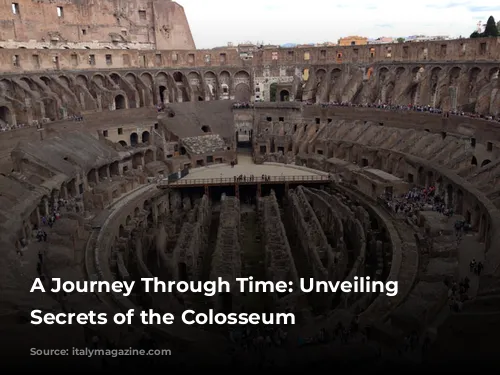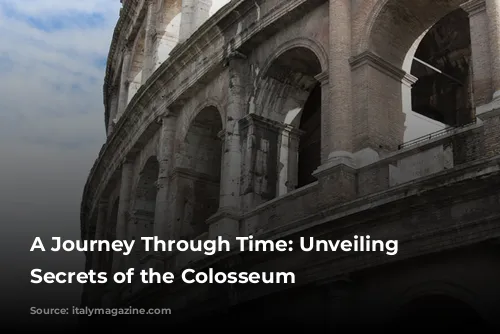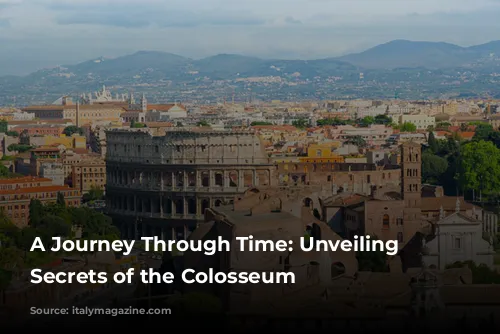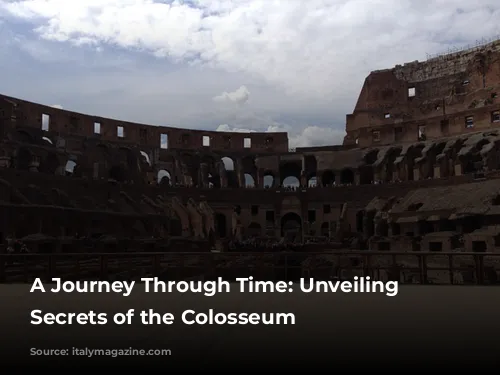Prepare to be transported back in time! On a recent trip to Rome, I had the incredible opportunity to explore the Colosseum’s hidden depths, areas typically off-limits to regular visitors. Guided by the brilliant archeologist Agostina Appetecchia, known affectionately as “Nina,” from The Roman Guy, I discovered fascinating stories and secrets that brought this iconic landmark to life.

Beyond the Usual: A Glimpse into the Colosseum’s Heart
The Roman Guy offers a special tour that takes you beyond the ordinary Colosseum experience, granting access to the combat ground, the dungeons, and the third level. These restricted zones are not accessible with a standard ticket, offering a truly unique perspective.
Imagine stepping onto the very ground where gladiators fought! We entered the Colosseum, bypassing the usual queues, and found ourselves standing on the reconstructed combat ground, known in Latin as the arena, a term derived from the word for “sand.” The arena was covered with sand for a chilling reason – to absorb the blood that inevitably flowed during these brutal spectacles.
As we stood in the heart of the arena, I felt an electric current run through me. Gazing up at the towering bleachers, I tried to imagine the gladiators’ experience. Stepping out of the darkness of the dungeons, they faced a sea of faces – up to 70,000 bloodthirsty spectators – their cheers echoing through the vast amphitheater.

The Legends of the Gladiators: More Than Meets the Eye
Nina shared fascinating insights about these legendary warriors. Gladiators were revered figures, akin to today’s sports heroes and celebrities. They were symbols of courage, bravery, and discipline. But contrary to popular belief, they weren’t all tall, muscular, and handsome, like Russell Crowe in the film “Gladiator.”
Nina’s favorite gladiator? A bit of a surprise, perhaps, but she revealed that many were actually short and stocky, with some extra padding. This was actually advantageous, as the fat helped protect them from injuries. And despite their image on screen, gladiators fought bare-chested, not with armor.
Even if not always conventionally attractive, gladiators were heartthrobs! Many Roman women were said to have fallen head over heels for these brave warriors, even running away with them.

A Day of Blood and Spectacle: Unraveling the Colosseum’s History
The gladiatorial combats were the main event of the day, but the festivities started early in the morning. Before the gladiators took to the arena, the day began with the venatio, a thrilling spectacle of men hunting wild animals. During the lunch break, the crowd was entertained by public executions of criminals, a gruesome form of entertainment.
Then came the main event – the gladiatorial combats, known as the munera. These brutal displays of strength and skill were the climax of the day. While the violence may seem shocking to us today, the Colosseum was considered a family-friendly entertainment venue. It was an integral part of Roman social life, drawing enormous crowds from all walks of life.
The Colosseum’s Birth: A Monument to the People
It was Emperor Vespasian who envisioned this grand structure. In 72 AD, he decided to build the Colosseum on the site of Nero’s lavish Domus Aurea, the imperial residence. After Nero’s death, Vespasian wanted to return this land to the people of Rome. He had a brilliant idea: drain the lake that formed part of the Domus Aurea and use the land to build the Colosseum, which would become the largest amphitheater ever built, dedicated to the citizens of Rome.
The Colosseum’s original name was Anfiteatro Flavio, the Flavian Amphitheater, named after the Flavian dynasty, to which Vespasian and his successor Titus, who completed the construction, belonged. The name Colosseum comes from the massive 41-meter-high statue of Nero, called the Colosso (meaning “giant”), which once stood nearby.
Construction of the Colosseum was a feat of engineering. It took only eight years to complete this monumental structure, using 100,000 cubic meters of travertine to create a four-story edifice, 50 meters high. After two millennia, it still stands as a testament to the skill of ancient Roman architects and engineers. (If you ever wonder about the missing section, it was damaged by an earthquake in the Middle Ages.)
Descending to the Underworld: Exploring the Dungeons
Reluctantly leaving the arena, we descended into the Colosseum’s underworld – the dungeons. This area, once known as “hell,” was a dark, damp, and fetid place. Two underground floors housed corridors, stairs, rooms, cages for animals, and cells for criminals awaiting their fate. A corridor connected the dungeons to the gladiators’ living and training areas.
The dungeon served as the backstage of the Colosseum, but instead of being located to the sides of the stage, it was underground. A special lift transported animals and gladiators up to the combat ground.
A Bird’s-Eye View: The Third Level
Our journey continued upwards to the third level. The view from here is breathtaking. Looking outwards, you can see Via dei Fori Imperiali and the Roman Forum, offering a glimpse into the vastness of this ancient city. Looking inwards, you can see the entire Colosseum, a powerful reminder of its past glory.
While today’s Colosseum is a far cry from its original appearance, you can still feel the thrill of its history. Roughly four million people visit the Colosseum each year, drawn to its enduring power and the fascinating stories it holds. There is simply no other place in the world, in history, like the Colosseum.
To embark on your own journey through time, book your tour of the Colosseum with the Dungeons, Third Level, and Arena Stage here.
The Roman Guy offers a variety of small group tours in Rome, including a “Privileged Entrance” Vatican & Sistine Chapel Tour” and a fun-filled “Eco Rome Golf Cart Tour.” For more information about these tours, visit The Roman Guy’s website.
